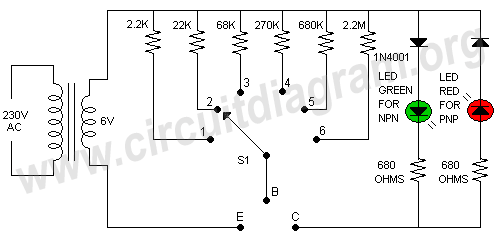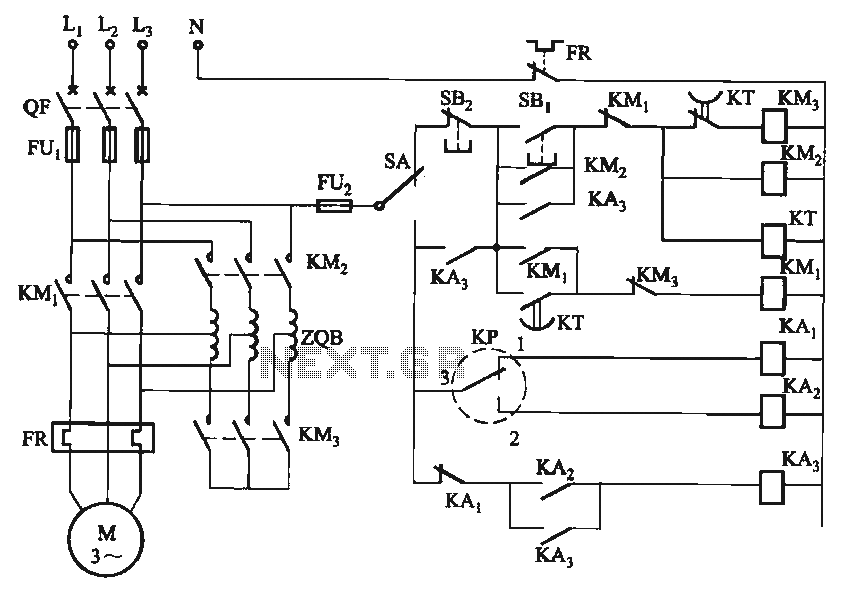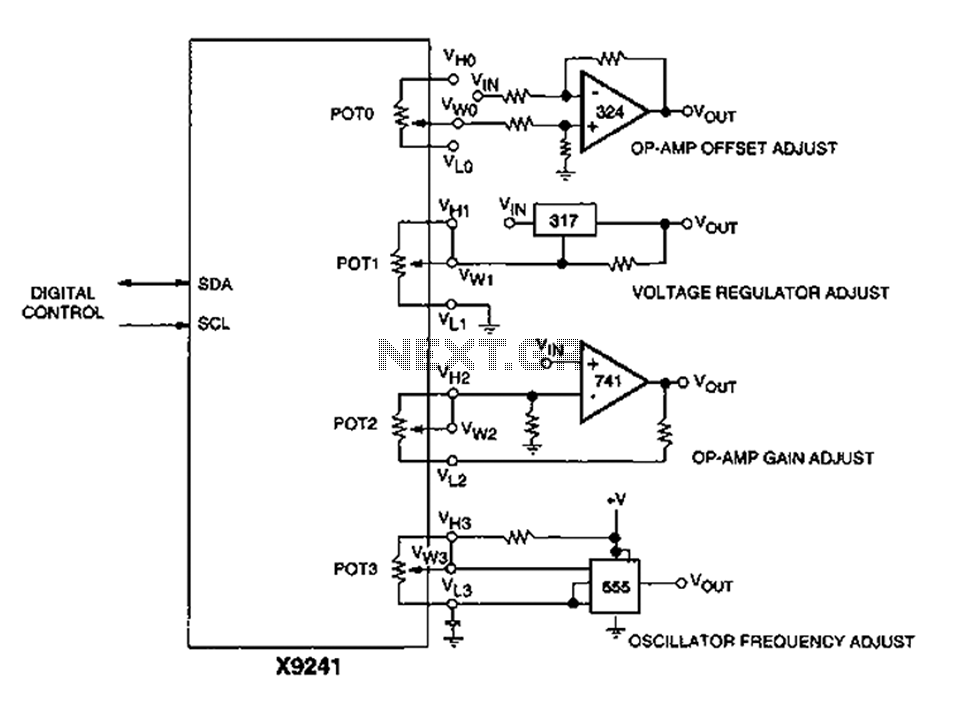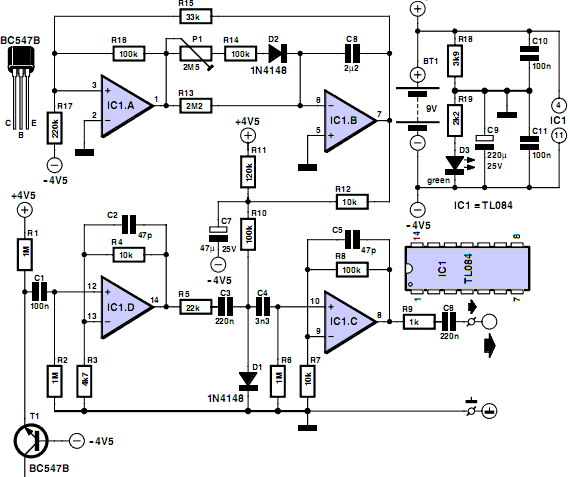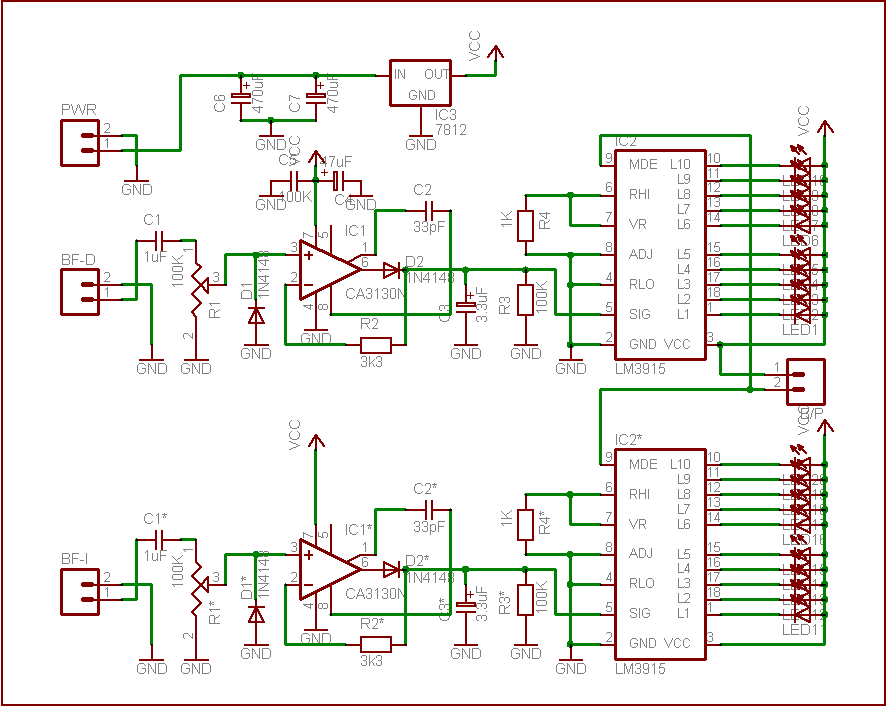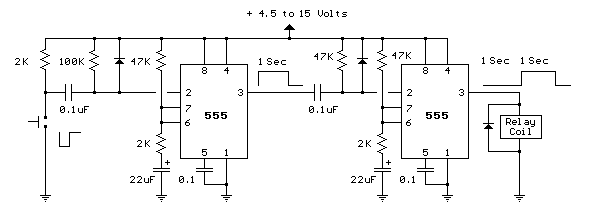
Discrete components stereo encoder circuit diagram
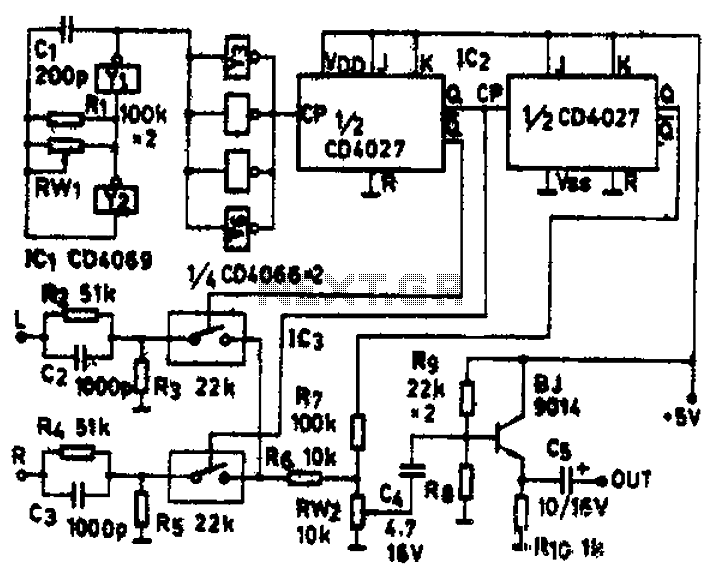
The circuit schematic diagram features IC1 (4069) and components Y1 and Y2, which together form a frequency oscillator operating at 76 kHz. Components Y3 to Y6 provide isolation and shape the output into the IC2 (CD4027) dual JK flip-flop, which consists of two frequency circuits generating symmetric square waves of +/- 38 kHz and 19 kHz. The +/- 38 kHz square wave is utilized to control the analog switch IC3 (CD4066). The circuit is designed to switch a stereo input audio signal with a frequency-modulated signal of 19 kHz, which is then mixed and isolated through a transistor (9014) FM modulator. The FM modulator circuit is referenced from various FM transmitter circuit designs available online. The objective is to enable users to enhance the functionality of older stereo FM transmitters, making it versatile for general-purpose applications.
The debugging process involves connecting the FM modulator to a five-volt power supply and measuring each pin of IC1 (CD4069) and IC2 (CP, Q) with a multimeter, ensuring that each pin reads half of the supply voltage, indicating proper oscillator startup. A digital frequency meter can be used to measure the output frequency of IC1, which can be adjusted to 75 kHz +/- 10 Hz using potentiometer RW1. If the frequency is not aligned, the radio can be tuned using RW2, followed by RW1, to ensure the radio's stereo indicator lights up without frequency howling from the speaker. The circuit accepts a stereo audio signal (1.5 Vpp) from the input terminal, allowing reception of stereo broadcasts on the radio. The input signal can alternatively be sourced from a line, necessitating an adjustment to resistor R7. Additionally, high-frequency noise can be minimized by adjusting R7, which, along with R6, serves as external components equivalent to pins 13-14 of the BA1404, facilitating the mixing of the pilot signal and composite signal before amplification. The circuit, utilizing the 9014 and BA1404, enters from pin 12, and there are numerous opportunities for improvements and developmental enhancements within this design. Circuit schematic diagram IC1-4069 the Y1, Y2 to form a frequency 76KHZ oscillator, Y3-Y6 isolation after shaping into the IC2 CD4027 dual JK flip-flop consisting of two compon ent frequency circuit that generates a symmetric +/- 38KHZ and 19KHZ square wave, square wave +/- 38KHZ which is used to control the analog switch IC3 CD4066, after stereo input audio signal switching with a frequency-modulated signal 19KHZ and then mixed into isolation after the transistor 9014 FM modulator. FM modulator circuit can be found in the site in a variety of FM transmitter circuits. This article is not shown, the purpose is to let the fans can easily use this encoder, not only can increase the functionality of your old stereo FM transmitter, but also as a general-purpose equipment.
Debugging is connected as the FM modulator and a five-volt power supply, measured with a multimeter IC1CD4069 each foot and IC2 CP, Q, Q, each foot should be half the supply voltage has been described oscillator start-up. If a digital frequency meter, measuring IC1 output frequency, the frequency is adjusted RW1 75KHZ +/- 10HZ can.
If not, can be aligned radio, RW2 half after a good tune, and then transferred RW1, make radio stereo indicator light, and the speaker is no temple frequency howling. And then into the stereo audio signal (1.5Vpp, available power amplifier output) from the input terminal at this time you will be able to receive stereo broadcasts on the radio.
The input signal can also be obtained from the line, but this time R7 should be changed accordingly. Finally, you can also adjust the high-frequency noise R7 minimum, in fact, R6, R7 is equivalent to BA1404 of 13-14 feet in external components, is a pilot signal and a composite signal mixing circuit and input to the amplifier, this circuit is 9014, and BA1404 in from 12 feet on entering, I think this circuit there are many places for improvement, development of what it might be interested in.
The debugging process involves connecting the FM modulator to a five-volt power supply and measuring each pin of IC1 (CD4069) and IC2 (CP, Q) with a multimeter, ensuring that each pin reads half of the supply voltage, indicating proper oscillator startup. A digital frequency meter can be used to measure the output frequency of IC1, which can be adjusted to 75 kHz +/- 10 Hz using potentiometer RW1. If the frequency is not aligned, the radio can be tuned using RW2, followed by RW1, to ensure the radio's stereo indicator lights up without frequency howling from the speaker. The circuit accepts a stereo audio signal (1.5 Vpp) from the input terminal, allowing reception of stereo broadcasts on the radio. The input signal can alternatively be sourced from a line, necessitating an adjustment to resistor R7. Additionally, high-frequency noise can be minimized by adjusting R7, which, along with R6, serves as external components equivalent to pins 13-14 of the BA1404, facilitating the mixing of the pilot signal and composite signal before amplification. The circuit, utilizing the 9014 and BA1404, enters from pin 12, and there are numerous opportunities for improvements and developmental enhancements within this design. Circuit schematic diagram IC1-4069 the Y1, Y2 to form a frequency 76KHZ oscillator, Y3-Y6 isolation after shaping into the IC2 CD4027 dual JK flip-flop consisting of two compon ent frequency circuit that generates a symmetric +/- 38KHZ and 19KHZ square wave, square wave +/- 38KHZ which is used to control the analog switch IC3 CD4066, after stereo input audio signal switching with a frequency-modulated signal 19KHZ and then mixed into isolation after the transistor 9014 FM modulator. FM modulator circuit can be found in the site in a variety of FM transmitter circuits. This article is not shown, the purpose is to let the fans can easily use this encoder, not only can increase the functionality of your old stereo FM transmitter, but also as a general-purpose equipment.
Debugging is connected as the FM modulator and a five-volt power supply, measured with a multimeter IC1CD4069 each foot and IC2 CP, Q, Q, each foot should be half the supply voltage has been described oscillator start-up. If a digital frequency meter, measuring IC1 output frequency, the frequency is adjusted RW1 75KHZ +/- 10HZ can.
If not, can be aligned radio, RW2 half after a good tune, and then transferred RW1, make radio stereo indicator light, and the speaker is no temple frequency howling. And then into the stereo audio signal (1.5Vpp, available power amplifier output) from the input terminal at this time you will be able to receive stereo broadcasts on the radio.
The input signal can also be obtained from the line, but this time R7 should be changed accordingly. Finally, you can also adjust the high-frequency noise R7 minimum, in fact, R6, R7 is equivalent to BA1404 of 13-14 feet in external components, is a pilot signal and a composite signal mixing circuit and input to the amplifier, this circuit is 9014, and BA1404 in from 12 feet on entering, I think this circuit there are many places for improvement, development of what it might be interested in.
